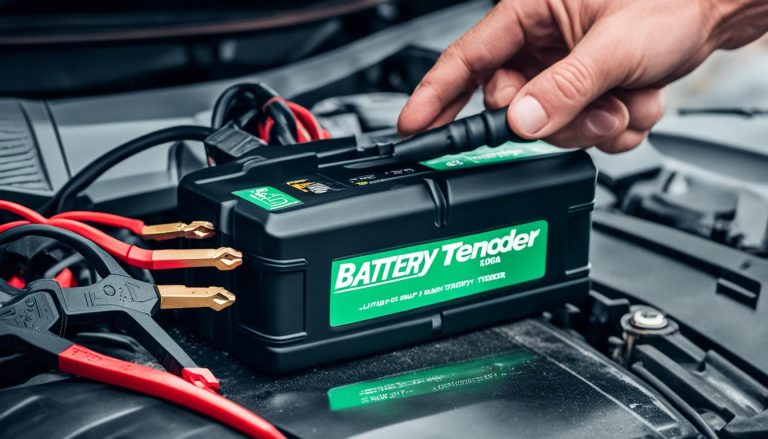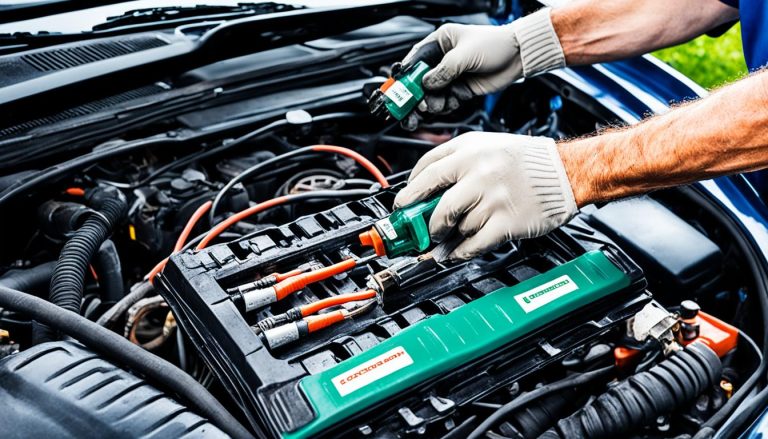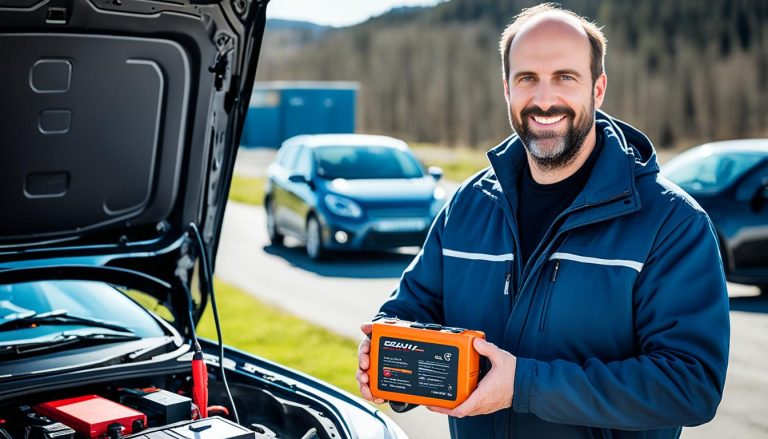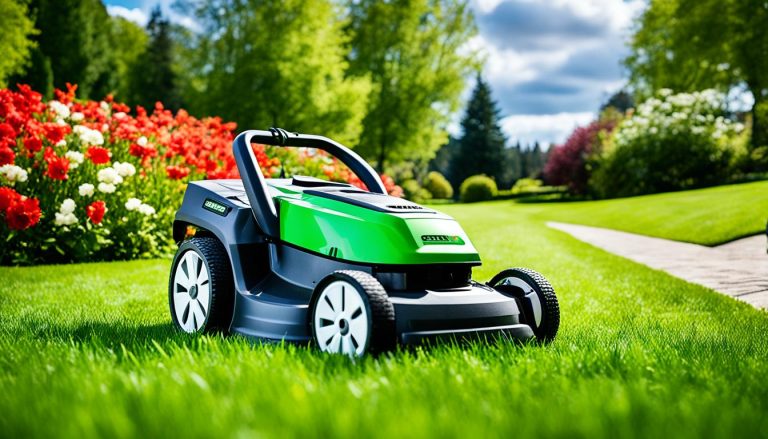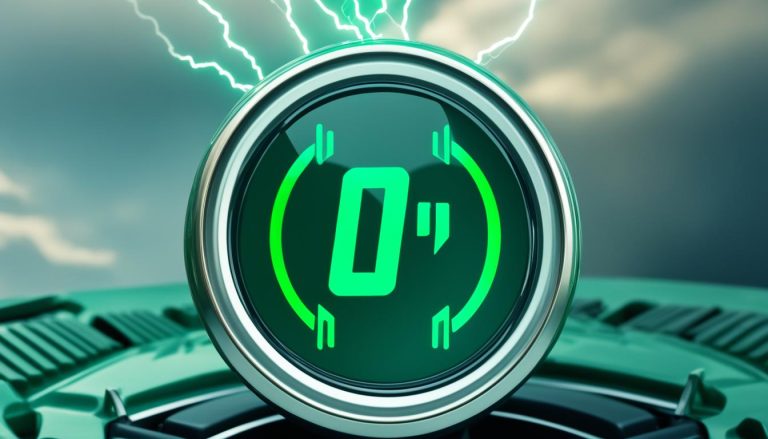How to Jump Start a Frozen Battery Safely
batterychargers.site and its partners may earn a commission if you purchase a product through one of our links
If you’re facing the chilly dilemma of how to jump start a frozen battery, it’s critical to approach the situation with caution and foresight. Winter’s frigid embrace can leave your vehicle’s battery helpless, turning what would be a simple boost into a precarious task. Before venturing out into the cold to revive your car, understanding the proper techniques to jump starting a frozen battery is paramount for your safety and the longevity of your vehicle.
Embarking on jump starting a frozen battery without the necessary know-how not only puts you at risk but could also compound your car troubles, leading to possible battery failure and the need for a costly replacement. Let’s ensure that you’re equipped with the knowledge to handle a frozen battery with care, avoiding the common pitfalls that can occur during these chillier months.
Key Takeaways
- Always assess the state of your battery before attempting to jump start a frozen battery.
- Thawing the battery is a crucial step and must be done safely to prevent potential hazards.
- Connecting jumper cables correctly is essential to avoid damage to your vehicle’s electrical system.
- Wearing protective gear and ensuring good ventilation are key safety precautions during the process.
- If your efforts don’t succeed, professional assistance or battery replacement may be necessary.
- Proper preventive measures can minimize the chances of your battery freezing in the future.
Understanding the Risks of a Frozen Battery
Before you attempt a frozen battery jump start, it’s vital to grasp the risks involved. A frozen battery isn’t just another hurdle in your morning routine; it can be a serious safety issue. Let’s delve into the specifics of how batteries reach a frozen state and the cautionary signs to look out for that may indicate potential danger. Knowing these details will help you jump start frozen battery scenarios with confidence and care.
The Chemistry Behind Battery Freezing
When contemplating a jump start dead frozen battery, understanding the chemistry that leads to freezing is crucial. A car battery contains water and sulfuric acid. Under normal circumstances, this acidic solution is maintained at a low freezing point, protecting it against typical winter temperatures. However, as the battery discharges, the concentration of sulfuric acid decreases, raising the freezing point. Ultimately, this can result in a frozen state where the acid begins interacting with the lead plates inside the battery, creating a volatile situation that can easily be exacerbated by an incorrect jump-start procedure.
Warning Signs of a Frozen Battery
If you suspect your battery might be frozen, look for these warning signs before attempting a jump start dead frozen battery. A cracked or bulging battery case can indicate expansion from ice formation, and the absence of sloshing liquid when you gently tip the battery suggests the solution inside has solidified. Ignoring these red flags can lead to a failed jump start and might even cause the battery to rupture or explode due to internal pressure if the frozen cells crack. Always prioritize your safety by thoroughly inspecting the battery’s condition. If you find that your battery shows any of these symptoms, consider it a no-go for a jump start.
- Cracks in the battery case may suggest internal ice expansion
- Bulging sides on the battery are a strong indicator of freezing
- Silence when shaking the battery means the electrolyte could be solid
Awareness of these risks and signals ensures that when you’re faced with a cold morning and a car that won’t start, you’ll be fully equipped to manage a frozen battery jump start with the necessary precautions.
Initial Assessment for a Frozen Battery
When the mercury dips, the last thing you want is a car that won’t start. Before you think about jump starting a frozen car battery, it’s crucial to conduct an initial assessment. This ensures your safety and protects your vehicle from potential damage. Here’s your abbreviated frozen battery jump starting guide to accurately assess the situation.
How to Identify a Frozen Battery
To avoid the pitfalls of jump starting a potentially hazardous frozen battery, your first move is to inspect cautiously. Look for any signs of leakage, and examine the case for cracks and bulges that may have developed as a result of freezing and expanding internal components. Additionally, listen for the sloshing sound of liquid inside the battery – silence may indicate a frozen state. Only when you’re certain the battery isn’t damaged should you consider the next steps.
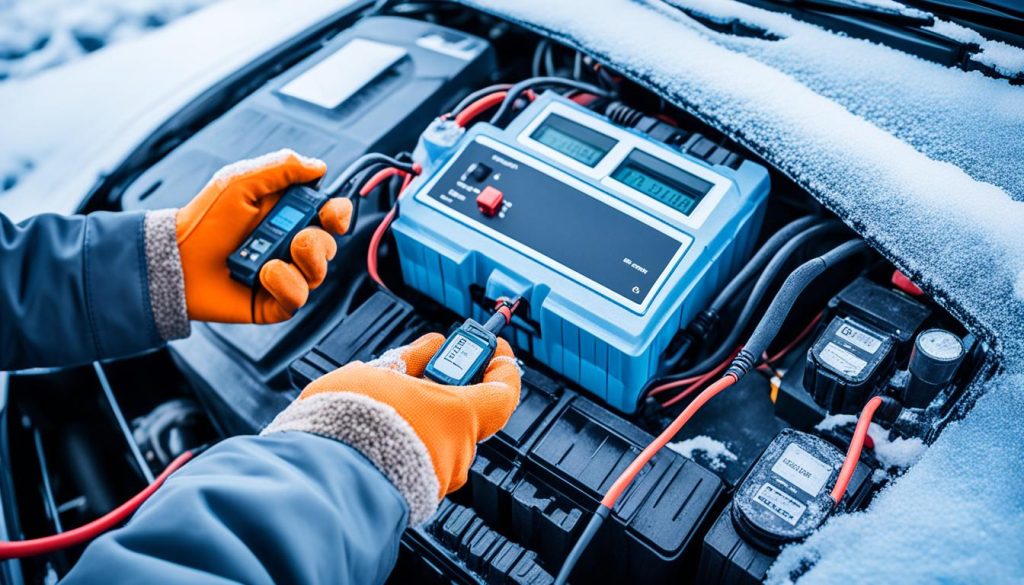
When to Avoid Jump Starting
If you observe that the battery casing is fractured or there is evidence of acid leakage, refrain from trying to jump start. These are telltale signs that the battery cells may be compromised, making the jump starting process dangerous. When these red flags appear, the safest recourse is to seek a replacement from a trusted automotive service provider. Your safety is paramount, and it’s better to err on the side of caution with a vehicle’s electrical system.
Remember, successful jump starting frozen car battery takes meticulous attention to detail. Not all batteries are created equal, and the wrong move could mean turning a fixable issue into one that requires professional intervention. So, always prioritize a thorough assessment before taking any further action.
Preparing to Jump Start a Frozen Battery
Before you attempt to bring your car back to life with a jump start, make sure your battery is properly thawed and damage-free. Here’s a checklist of tips for jump starting a frozen battery that will help you get ready for a successful and safe reboot of your vehicle’s power source.
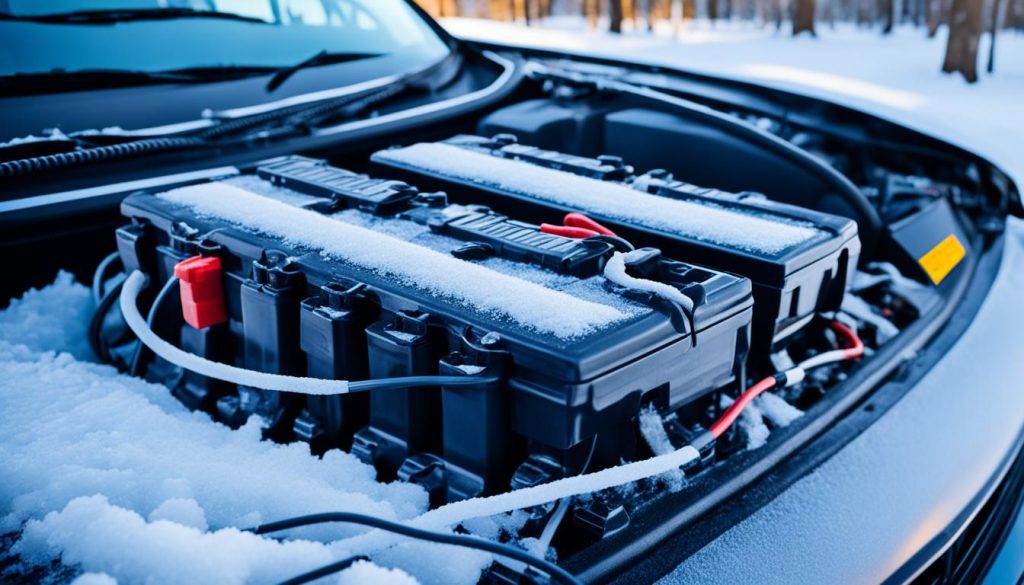
- Inspect the battery: Ensure there’s no visible damage or cracks on the battery casing.
- Gather your equipment: You’ll need a set of reliable jumper cables, a donor vehicle, and safety gear such as gloves and goggles.
- Know your battery: Understand whether you have a maintenance-free or a low-maintenance battery as the approach might differ slightly.
- Find a safe location: Ensure you are far from traffic and other hazards, on a stable, flat surface.
- Ensure proper connection: Familiarize yourself with the proper cable connection procedure to avoid short circuits or sparks.
Remember, the goal is not just to start your car but to do so without causing harm to yourself, the battery, or the car’s electrical system. Take your time and follow these steps carefully to ensure a smooth and safe process.
Always prioritize safety and proceed with caution. If you’re unsure at any point, it’s best to seek professional help.
Step-by-Step Process to Jump Start a Frozen Battery
Dealing with a frozen battery in the winter months can be a daunting situation. However, knowledge of the correct procedures can spare you the inconvenience of being stranded. The key to reviving your vehicle lies in safely restoring power to your frozen battery. Here’s a detailed guide on how to jump start a frozen battery without risking your safety or causing damage to your vehicle.
Safely Thawing Your Frozen Battery
Before you can start the process of jump starting, you have to ensure that your battery is sufficiently thawed. This step is crucial as attempting to charge a frozen battery can result in permanent damage. One effective method is to use an engine block heater if available. Alternatively, moving your vehicle to a heated garage can gradually bring the battery up to a manageable temperature.
Connecting Jumper Cables the Right Way
Once you’ve confirmed that the battery is thawed, you can proceed to connect the jumper cables. Remember to always connect the red cable to the positive (+) terminal of your dead battery first, and then to the donor battery. Follow this by connecting the black cable to the negative (-) terminal of the donor battery, and finally to an unpainted metal surface on your car’s engine block or chassis away from the battery. This step helps in setting up a safe path for the electricity to jump start your frozen battery.
Starting the Engine After Jump Starting
After connecting the cables, start the engine of the donor vehicle first, and let it idle for a few minutes. Now it’s time to attempt starting your car. If it doesn’t start right away, don’t fret—sometimes it requires patience and a few tries. Should the engine remain inactive, your battery may need a full charge or possibly a replacement. In such cases, don’t hesitate to contact a professional for assistance.
Understanding how to jump start a frozen battery is an invaluable skill that can prevent a lot of winter troubles. With these steps, you’re now prepared to handle this chilly challenge. Remember, safety is paramount. Always prioritize it while handling a frozen battery.
Jump Start a Frozen Battery: Essential Safety Precautions
Ensuring your safety is paramount when dealing with the task to jump start a frozen battery. Before beginning the process, it is important to equip yourself with the correct protective gear and have emergency measures in place. Not only will this protect you, but it will also help prevent any further damage to the battery or vehicle.
Protective Gear and Emergency Measures
To guarantee optimal frozen battery jump start safety, you must don protective gloves and safety eyewear. These will shield your hands and eyes from any potential sparks or corrosive materials during the jump start procedure. Additionally, it’s advisable to have a first aid kit and an emergency phone number at the ready, should any accidents occur.
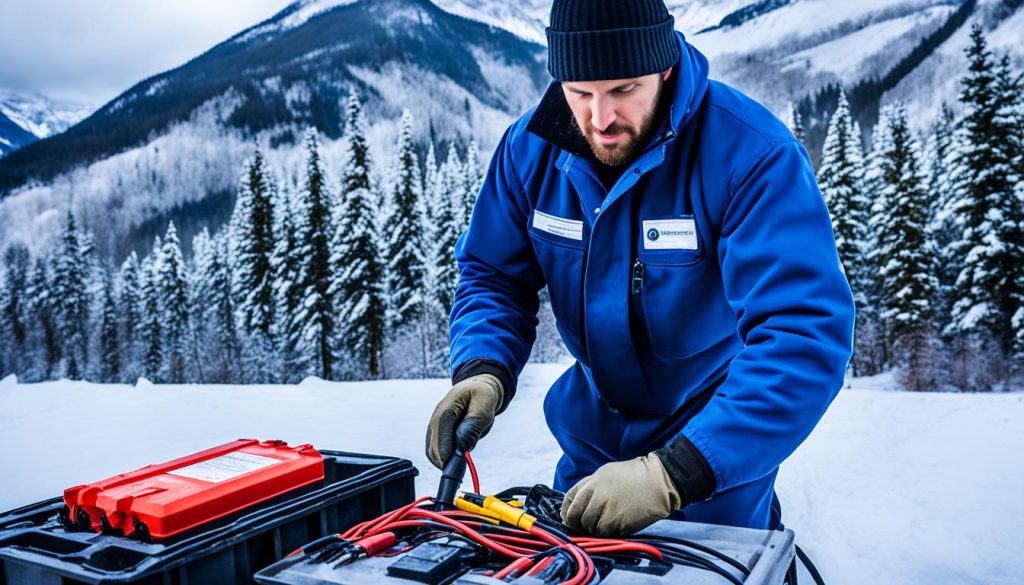
Ensuring Proper Ventilation and Handling of Chemicals
When attempting to jump start a frozen battery, ensuring that the workspace is well-ventilated cannot be overstressed. Good air circulation is key to avoiding the inhalation of hazardous fumes that batteries may emit. In the event of a sulfuric acid spill, be prepared with a mixture of baking soda and water to neutralize the acid effectively.
| Protective Gear | Emergency Supplies | Handling and Ventilation |
|---|---|---|
| Gloves and safety eyewear | First aid kit, emergency contact numbers | Well-ventilated workspace |
| Gloves to protect against acid and sparks | Baking soda to neutralize acid spills | Avoid working in a closed space |
| Full-face shield for additional protection | Fire extinguisher for electrical or chemical fires | Keep the battery upright to prevent spills |
- Always use insulated tools to prevent electrical shorts.
- Keep a constant check on the battery temperature.
- Stand at a safe distance when charging or jump starting.
Recollecting these precautions not only ensures your safety but also proves pivotal for the success of the jump start operation. Remember, while jump starting a frozen battery can be a straightforward process, overlooking critical safety measures can result in serious injury or property damage.
Preventive Measures to Keep Your Battery from Freezing
As winter approaches, preventing your car battery from freezing becomes a crucial aspect of vehicle maintenance. Simple steps can significantly increase your battery’s resilience against the frigid weather. Whether you’re gearing up for a mild chilly season or bracing for a polar vortex, understanding battery maintenance in cold weather will help you bypass the inconvenience and potential hazards of a frozen battery.
Regular Battery Maintenance Tips
Maintenance is key in ensuring your battery’s longevity especially when the thermometer dips. Regularly checking and cleaning your battery terminals to prevent corrosion can help maintain a strong connection. Additionally, ensure that your battery is firmly secured in its mount, as vibrations can damage the battery’s internal components and lead to a shortened lifespan.

Best Practices for Battery Longevity in Cold Climates
To further safeguard your car battery from freezing temperatures, consider implementing these best practices:
- Make a habit of parking your vehicle in a garage or another covered space to minimize exposure to cold weather conditions.
- Prioritize regular driving schedules; a dormant vehicle leads to a discharged battery, which is more susceptible to freezing.
- Always remember to turn off headlights, cabin lights, and any electronics after parking to prevent unnecessary battery drain.
Moreover, tools like trickle chargers and battery blankets are excellent investments for those living in areas with extreme winter weather. They help maintain the battery’s temperature and charge, further preventing a frozen car battery.
| Cold Weather Tool | Function | Benefit |
|---|---|---|
| Trickle Charger | Provides a consistent low charge | Keeps battery topped up |
| Battery Blanket | Wraps around the battery to warm it | Prevents freezing and maintains optimal performance |
| Antifreeze | Added to the engine coolant | Ensures the engine and battery operate at a stable temperature |
By being proactive with your car’s battery maintenance and adopting these best practices for battery longevity, you can ease the bite of winter and keep your battery functioning smoothly, no matter how low the mercury goes.
What to Do if Your Frozen Battery Can’t Be Jump Started
If your efforts to jump start a frozen battery have been met with frustration, it might be time for frozen battery replacement. Despite your best attempts at troubleshooting, certain scenarios render a battery beyond revival. In such situations, it is crucial not to risk further damage to your vehicle or compromise your safety. The efficient and secure option is to seek the expertise of professionals with experience in frozen battery troubleshooting.
Going beyond DIY methods, professional services like AutoNation Mobile Service provide ASE-certified mechanics to tackle your car troubles head-on. They are equipped to deliver high-quality replacement services, ensuring that your new battery complies with your vehicle’s specifications. A warranty on their service gives you the peace of mind that comes from knowing you’re covered if any issues arise post-installation.
If your car has experienced the winter woes of a frozen battery, know that a replacement from trusted experts is a steadfast solution. Their proficiency will not only resolve your current issue but will also help to prevent future incidents. With professional help, you can rest assured that your vehicle is in capable hands and ready to brave the cold without a hitch.
FAQ
How can you safely jump start a frozen battery?
To safely jump start a frozen battery, first ensure the battery is thawed and shows no signs of damage. Use proper protective gear, connect the jumper cables correctly, start the engine cautiously, and follow all safety precautions to avoid risks of explosion or chemical burns.
What are the risks of attempting to jump start a frozen battery?
Risks include the potential for the battery to explode due to increased internal pressure, the emission of harmful gases, and possible chemical burns from sulfuric acid. A frozen battery that is damaged could also pose a risk of short circuiting and fire when jump-started.
What are the signs that a car battery is frozen?
Signs of a frozen battery include a cracked battery case, bulging sides, and lack of a liquid sloshing sound when the battery is moved. If you notice these signs, you should not attempt to jump start the battery.
How do you identify a frozen battery before attempting a jump start?
Inspect the battery for any physical damage such as cracks or bulges. Check the battery fluid levels in each cell—if the fluid is frozen or you see damage, do not attempt to jump start. It’s best to thaw the battery first and ensure it’s in good condition.
What should you do if a battery is frozen and requires a jump start?
If you determine the battery is frozen but undamaged, gently thaw it using safe heat sources like engine block heaters or moving it to a warmer location. Once fully thawed, proceed with jump-starting using proper precautions.
How do you properly connect jumper cables to a frozen battery?
With the battery thawed and other safety checks complete, first connect the positive (red) clamp to the positive terminal of the frozen battery, then connect the other positive clamp to the booster vehicle’s positive terminal. Next, connect the negative (black) clamp to the booster vehicle’s negative terminal, and attach the other negative clamp to an unpainted metal surface on the engine block of the car with the frozen battery, away from the battery itself, to complete the circuit safely.
What should you do if the engine doesn’t start after jump starting a frozen battery?
If the engine doesn’t start, wait a few minutes and try again, ensuring the connections are secure. If it still doesn’t start, the battery may require a full charge or replacement. Consider seeking professional assistance.
What are essential safety precautions when jump starting a frozen battery?
Wear gloves and protective eyewear to guard against acid and fragments in case of a cracked battery. Ensure the area is well-ventilated to disperse any hazardous gases, and have baking soda and water on hand to neutralize any acid spills.
How can you prevent your car battery from freezing?
Keep your battery fully charged, regularly drive your vehicle to maintain battery fluid circulation, use a trickle charger or battery blanket in very cold climates, and park in sheltered or warmer areas to reduce the risk of freezing.
What are the best practices for maintaining battery longevity in cold climates?
Regularly check your battery’s charge and keep it clean, use appropriate antifreeze in your vehicle, remove electrical accessories or chargers when not in use, and consider using tools like battery warmers to help maintain optimal battery function in cold conditions.
What steps should you take if your frozen battery won’t jump start?
If a frozen battery fails to respond to a jump start, it may need to be recharged or replaced. Professional services can assist with safe handling and installation of a new battery, especially if there’s a risk of battery damage.

